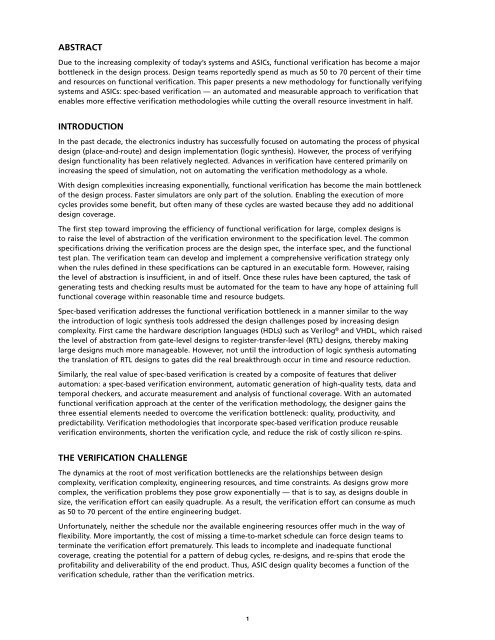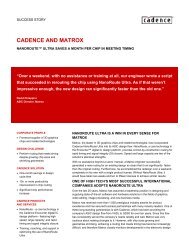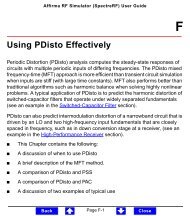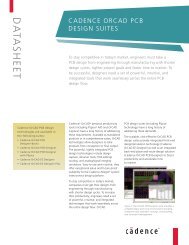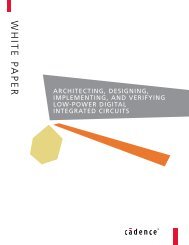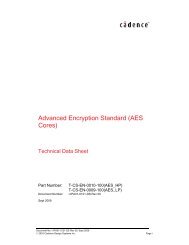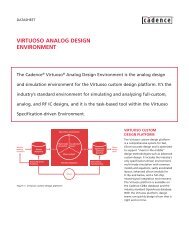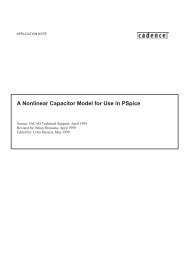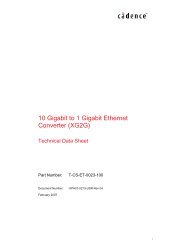Spec-based verification: A new method for functional ... - Cadence
Spec-based verification: A new method for functional ... - Cadence
Spec-based verification: A new method for functional ... - Cadence
You also want an ePaper? Increase the reach of your titles
YUMPU automatically turns print PDFs into web optimized ePapers that Google loves.
ABSTRACTDue to the increasing complexity of today’s systems and ASICs, <strong>functional</strong> <strong>verification</strong> has become a majorbottleneck in the design process. Design teams reportedly spend as much as 50 to 70 percent of their timeand resources on <strong>functional</strong> <strong>verification</strong>. This paper presents a <strong>new</strong> <strong>method</strong>ology <strong>for</strong> <strong>functional</strong>ly verifyingsystems and ASICs: spec-<strong>based</strong> <strong>verification</strong> — an automated and measurable approach to <strong>verification</strong> thatenables more effective <strong>verification</strong> <strong>method</strong>ologies while cutting the overall resource investment in half.INTRODUCTIONIn the past decade, the electronics industry has successfully focused on automating the process of physicaldesign (place-and-route) and design implementation (logic synthesis). However, the process of verifyingdesign <strong>functional</strong>ity has been relatively neglected. Advances in <strong>verification</strong> have centered primarily onincreasing the speed of simulation, not on automating the <strong>verification</strong> <strong>method</strong>ology as a whole.With design complexities increasing exponentially, <strong>functional</strong> <strong>verification</strong> has become the main bottleneckof the design process. Faster simulators are only part of the solution. Enabling the execution of morecycles provides some benefit, but often many of these cycles are wasted because they add no additionaldesign coverage.The first step toward improving the efficiency of <strong>functional</strong> <strong>verification</strong> <strong>for</strong> large, complex designs isto raise the level of abstraction of the <strong>verification</strong> environment to the specification level. The commonspecifications driving the <strong>verification</strong> process are the design spec, the interface spec, and the <strong>functional</strong>test plan. The <strong>verification</strong> team can develop and implement a comprehensive <strong>verification</strong> strategy onlywhen the rules defined in these specifications can be captured in an executable <strong>for</strong>m. However, raisingthe level of abstraction is insufficient, in and of itself. Once these rules have been captured, the task ofgenerating tests and checking results must be automated <strong>for</strong> the team to have any hope of attaining full<strong>functional</strong> coverage within reasonable time and resource budgets.<strong>Spec</strong>-<strong>based</strong> <strong>verification</strong> addresses the <strong>functional</strong> <strong>verification</strong> bottleneck in a manner similar to the waythe introduction of logic synthesis tools addressed the design challenges posed by increasing designcomplexity. First came the hardware description languages (HDLs) such as Verilog ® and VHDL, which raisedthe level of abstraction from gate-level designs to register-transfer-level (RTL) designs, thereby makinglarge designs much more manageable. However, not until the introduction of logic synthesis automatingthe translation of RTL designs to gates did the real breakthrough occur in time and resource reduction.Similarly, the real value of spec-<strong>based</strong> <strong>verification</strong> is created by a composite of features that deliverautomation: a spec-<strong>based</strong> <strong>verification</strong> environment, automatic generation of high-quality tests, data andtemporal checkers, and accurate measurement and analysis of <strong>functional</strong> coverage. With an automated<strong>functional</strong> <strong>verification</strong> approach at the center of the <strong>verification</strong> <strong>method</strong>ology, the designer gains thethree essential elements needed to overcome the <strong>verification</strong> bottleneck: quality, productivity, andpredictability. Verification <strong>method</strong>ologies that incorporate spec-<strong>based</strong> <strong>verification</strong> produce reusable<strong>verification</strong> environments, shorten the <strong>verification</strong> cycle, and reduce the risk of costly silicon re-spins.THE VERIFICATION CHALLENGEThe dynamics at the root of most <strong>verification</strong> bottlenecks are the relationships between designcomplexity, <strong>verification</strong> complexity, engineering resources, and time constraints. As designs grow morecomplex, the <strong>verification</strong> problems they pose grow exponentially — that is to say, as designs double insize, the <strong>verification</strong> ef<strong>for</strong>t can easily quadruple. As a result, the <strong>verification</strong> ef<strong>for</strong>t can consume as muchas 50 to 70 percent of the entire engineering budget.Un<strong>for</strong>tunately, neither the schedule nor the available engineering resources offer much in the way offlexibility. More importantly, the cost of missing a time-to-market schedule can <strong>for</strong>ce design teams toterminate the <strong>verification</strong> ef<strong>for</strong>t prematurely. This leads to incomplete and inadequate <strong>functional</strong>coverage, creating the potential <strong>for</strong> a pattern of debug cycles, re-designs, and re-spins that erode theprofitability and deliverability of the end product. Thus, ASIC design quality becomes a function of the<strong>verification</strong> schedule, rather than the <strong>verification</strong> metrics.1


